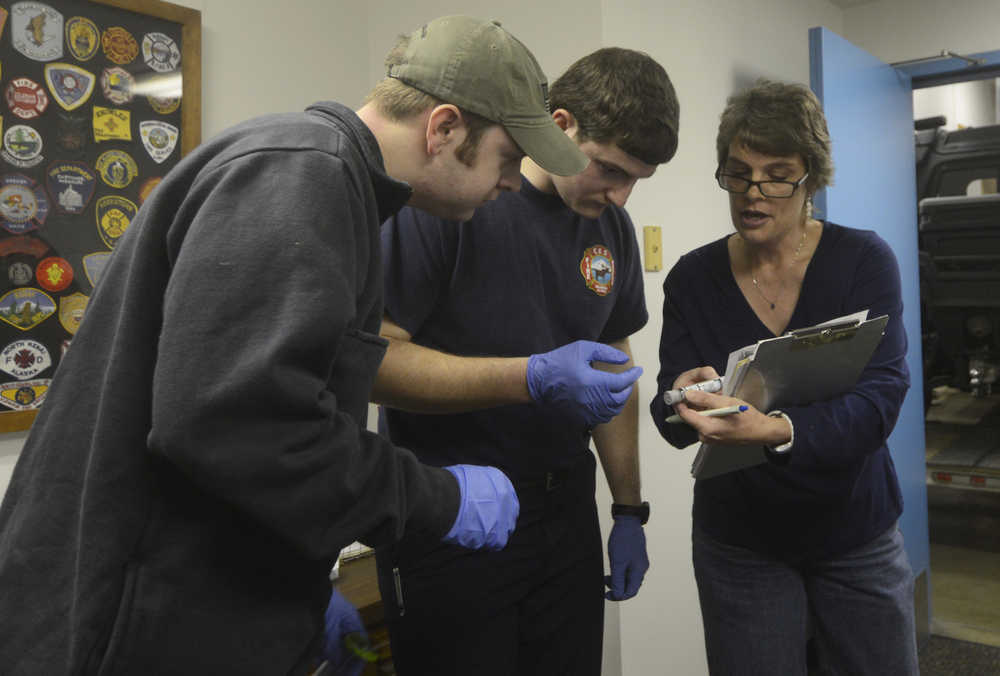Though she describes herself as “organized chaos,” Megan Nathe’s bedroom looks ready to pass the most thorough of inspections, with not a pen out of place and labels stuck to her several metal lockers.
What’s more, her commute to work consists of a left turn out of her room and a stroll through the kitchen into a bay of emergency engines, tankers and other firefighting equipment.
Nathe is a resident volunteer who lives full-time at the Central Emergency Services station in Kasilof. A member of the inaugural class of department volunteers since the program officially launched in July 2015, Nathe is among the ranks of those who supplement career firefighters and first responders to keep the Central Emergency Services Area covered more thoroughly.
“As a resident, the people in the community get to know your face and they get to know that you’re there, so if they need anything they can always come to you,” Nathe said.
CES staff are tasked with responding to emergencies in a 1,000-square-mile area. While using volunteers has been common for years, having more of them was identified when the department re-evaluated its previous volunteer program, former Chief Chris Mokracek told the Clarion in a previous interview.
Former CES Captain Dick Kapp came out of retirement to coordinate the new program, which provides people from the community with $100 stipends for each full shift they cover. The program has a total of 50 volunteers, including those who were already giving their time and were grandfathered in.
The volunteers are required to take a basic firefighting and a basic emergency medical response course, and have the option of taking a driver and operator course to be able to move CES vehicles from place to place.
Volunteers can also sign up to receive tuition reimbursements for the classes they need to take to be volunteers through Kenai Peninsula College.
“We’ve had some bumps along the road, but we knew we’d have bumps,” Kapp said. “But we haven’t had any disasters. And it’s still a work in progress, we’re still adapting. There’s many, many of these programs throughout the United States and many in the state of Alaska, so we were able to glean from those information and kind of combine their policies (and) procedures with our wants and needs.”
Kapp and others are in the process of training the third class of volunteers — “generation three,” as Kapp calls them. They attend Tuesday night drill sessions along with the first two volunteer groups to stay up to date on their techniques.
The volunteers range in age and previous training. Some, like 20-year-old Jessica Roper, have attended school for firefighting and to be emergency medical technicians, while others enter the program with relatively little prior experience.
Roper got her start in the Explorers Program when she was 15, before going to college for her associate’s degree in paramedic technology.
“My neighbor was a paramedic, and I was always interested in, like when you see an ambulance driving down the road and you’re like, ‘Oh, what’s going on?’ That was me,” Roper said. “I always wanted to follow them.”
Some, like Tyler Schlung of Soldotna, are what he called “grandfathers,” those who have been volunteering with CES long before the new program was implemented.
“I think it’s a great program,” he said. “I think they made a real emphasis on getting local people involved.”
Volunteers respond to emergencies for CES on top of their day jobs and other obligations. Schlung said he took on volunteer duties in addition to teaching at Kenai Middle School and flying for the Civil Air Patrol — an auxiliary of the U.S. Air Force — because he wanted to give something back to the community that had given so much to him.
“It’s been about 10 years,” he said of his time with CES. “I’d just come back from teaching out in the Bush and I was just looking for a way to give back to the community. Kenai’s been good to my family. … I think as you get older you think more about what you can give back to the community.”
While the revamped volunteer program has brought a host of supplemental first responders into the department and stations, some firefighters are being asked to go one step further. CES has a resident program, in which first responders live year-round in one of the service area’s two more remote stations in Kasilof and Funny River.
Nathe, who already had experience in wildland firefighting, said she signed up to be a resident in order to get the most diverse experience she could.
“When you’re out there on a wildland assignment … and people are doing structure protection, you don’t really know what they do, you don’t know their side of things,” she said. “Since I’ve been doing this, you get that feeling of what they have to do and how important it is … so now I know what that feels like. It’s kind of cool to see both sides of the defense.”
Schlung said one strength of the program is its ability to give young people who might be new to the area a way to create a foothold in the community, and sets up a situation in which more established residents are mentoring newcomers.
“It’s just another way to get plugged in, and I think people want that,” he said. “I think they want a way to give back to their community in a meaningful way.”
As the program moves forward, Kapp said CES will keep it stable at its current level of 50 volunteers. He wants to move away from training large classes at one time — the inaugural class had 26 members — and introduce people slowly to replace the volunteers who leave instead.
The third class of volunteers will be ready to start signing up for shifts in about 5 weeks, Kapp said.
Reach Megan Pacer at megan.pacer@peninsulaclarion.com.

